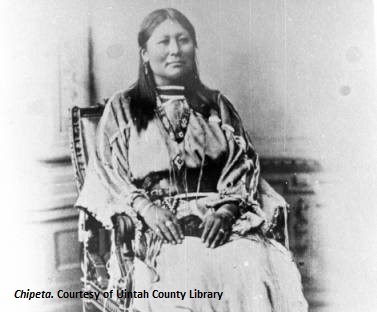Dublin Core
Title
Description
Ute leader Chipeta – her search for peace meant the loss of her home and her way of life.
Chipeta was the wife of Uncompahgre Ute leader Ouray and acted for years as a peacemaker between her people and the United States government. She stood alongside her husband in the negotiating halls of Washington D.C. She helped mediate between white settlers and angry Ute warriors. She tirelessly sought compromise to allow Ute people to stay in their Colorado homeland.
It didn’t matter. One summer morning in 1881, Chipeta found herself herded at gunpoint from her home in Colorado to a faraway reservation in Utah’s Uinta Basin.
Surrounded by nine companies of cavalry and an equal complement of infantry, the Utes were told to be ready in two hours. The order was emphasized with six pieces of field artillery. So, 1,458 men, women, and children set out on the 350-mile march to Utah. More than a thousand army troops watched the Utes leave peacefully. One soldier reported, “We saw … the whole Ute nation [streaming by] on horseback and on foot… As they passed our camps their gait broke into a run. Sheep were abandoned, blankets and personal possessions strewn along the road, women and children were loudly wailing. ...As we pushed the Indians onward, we permitted the whites to follow, and in three days the rich lands of the Uncompahgre were all occupied, towns were being laid out and lots being sold at high prices.”
The forced migration of the Uncompahgre Ute people mirrors the experiences of Indians all over the West. By the 1850s the U.S. government increasingly favored displacement of Indians onto reservations, often far away from their ancestral homes. For the Utes, the contrast in landscape between Colorado’s high mountains and Utah’s high desert could not have been starker.
Chipeta loved her “Shining Mountains” and had no desire to leave. Her journey to Utah was not her choice. Yet she did choose to foster peace between her people and the settlers who first encroached upon her home and eventually took it away.
Creator
Source
Image: Chipeta, no date. Courtesy of Uintah County Library.
______________
See Susan Lyman-Whitney, “Chipeta (1843-1924): She Didn’t Want to Come to Utah,” in Worth Their Salt: Notable but Often Unnoted Women of Utah (Colleen Whitley, ed.), Logan: Utah State University Press, 1996, pp. 76-88; Cynthia S, Becker and P. David Smith, Chipeta: Queen of the Utes, a Biography, Montrose, Colorado: Western Reflections, 2003; Cynthia S. Becker, Chipeta: Ute Peacemaker, Palmer Lake, Colorado: Filter Press, 2008; and H. Bert Jenson, "Chipeta: Glory and Heartache," Outlaw Trail Journal, Winter/Spring 1992, pp. 12-21; Lyman, June, and Norma Denver, Ute People: An Historical Study, 3d ed., Ed. Floyd A. O’Neil and John Sylvester, Salt Lake City: University of Utah, 1970; Clifford Duncan, “The Northern Utes” in Forrest S. Cuch, ed., A History of Utah’s American Indians (Salt Lake City: Utah State Division of Affairs and the Utah State Historical Society, 2000) available online at Utah Division of State History; “The Utes in Southwestern Colorado: A Confrontation of Cultures,” Frontier in Transition: A History of Southwestern Colorado, BLM Cultural Resources Series (Colorado: No. 10), available online at the National Park Service; Uintah County Heritage Museum, exhibition file for Chipeta: She Didn’t Want to Come to Utah, curated by LeeAnn Denzer, September 2014-2015.
Publisher
The Beehive Archive is a production of Utah Humanities. Find sources and the whole collection of past episodes at www.utahhumanities.org
Date
2014-09-12

